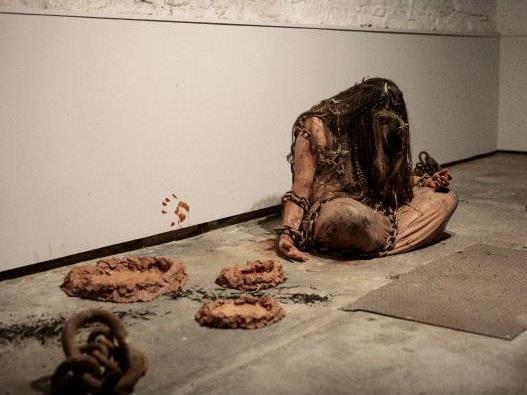Sinsa Mansell performing her work Instinct. Image: supplied by Constance ARI.
Opening as part of the Australian Ceramics Triennale 2019, Constellations Underground – styled as C o n s t e l l a t i o n s U n d e r g r o u n d – explores the materials of the body and of the earth, occupying a series of deep dark spaces in the bowels of the Hobart Town Hall. Curated by Constance Artist-Run Initiative’s Priscilla Beck, five artists from lutruwita (Tasmania) have explored the use of clay as object, body and sound.
Surrounded by thick colonial walls and barred windows, pakana (Aboriginal Tasmanian) dance artist Sinsa Mansell is the first to perform with her work Instinct. Holding space in the centre of the floor, she is surrounded by significant objects and marks: a single handprint, piles of chain, the ashes of burnt eucalypt leaves and three clay ponds of ochre. Cross-legged, her torso is curved forward pulled down by the weight of long chains. Slowly she unwinds her limbs freeing them to reach up and out towards the surrounding audience. These actions are simple but strong. Her constrained body follows with her face now raised and hands to chest. Leaning across the space she breaks open the walls of the clay dams. Dragging the liquid from each pond across the floor, like a network of rivers meeting and spreading up her limbs and onto the wall behind her, she writes ‘FIGHT TO SAVE OUR MOTHER’ before returning to her initial position.
Moving into the next room housing Jay Song’s installation shed (verb) (GET RID OF), we can reflect on the still life of a formal dining room with a central table, bowl of fruit and more in the dark corners. Except there is a twist. The bowls and vegetables are made from crisp white lumina porcelain, the table is an antique door and the industrial bridge-like legs support video screens which can only really be viewed by sitting underneath. Song sets a scene that invokes questions, which may only be answered once the audience has left.
In complete contrast the third room houses kýklōsis. Sound artist Julia Drouhin and ceramicist Georgie Vozar (both Tasmanian) fill the room with humanity. Propped on opposite pottery wheels, they are separated by a huge mound of clay. The light source is a large video screen on one wall. The audience shuffles around as the artists go about their work; one clearly an expert with the materials. This is a space full of tactile and audio extremes. Squelching liquid, dripping video images, wet sponges and scraping tools abound. Masked and clad in white, Drouhin and Vozar go about the pursuit of perfection. The floor is witness to their failures. Their performances are both focused and humorous, giving away nothing of their reason for their actions. Isolated from the other rooms, except for distant sounds of disaster, this is a cave of fiendish delight.
Moving through the final space, it is obvious that Luke Aleksandrow, a Canberra-based artist, has been replaced by an ambient track composed by Mat Ward, a Tasmanian sound artist. Eight piles of ceramics edge the room. These are the work of emerging and established artists Glenn Barkley, Richilde Flavell, Tessy King, Clairy Laurence, Kerryn Levy, Danny Murphy, Holly O’Meehan and Jenny Wong, reduced to shards. The Break Collection is Aleksandrow’s latest work in a series investigating the breakage of ceramic objects and the silence that follows. Delicate fragments shine up from the floor: glossy, coloured tubes and a face; eight pieces of past perfection now shattered as witness.
The stillness continues as we again pass Song’s installation and yes here too something has changed. Evidence of a disaster is now scattered on the floor; of an act, which only some of the audience may have randomly observed, but there no other indication of anything amiss as two other bowls wait their turn in the shadows.
Constellations Underground is an intriguing mixture of works with obvious links via the featured material of the parallel exhibitions and events of the Australian Ceramic Triennale 2019. Yet there is much more going on in this event, which at its core questions many aspects of ‘presence’ in performance. The use of the underground spaces traversed during the experience, both confines and unites each work as they deal with the relationship between an audience and a series of performative acts. The answers are equally various.
4 stars ★★★★
Constellations Underground
Exhibition 4-5 May 2019 (opening event and performances 3 May 2019)
Constance ARI, Town Hall Underground, Hobart





